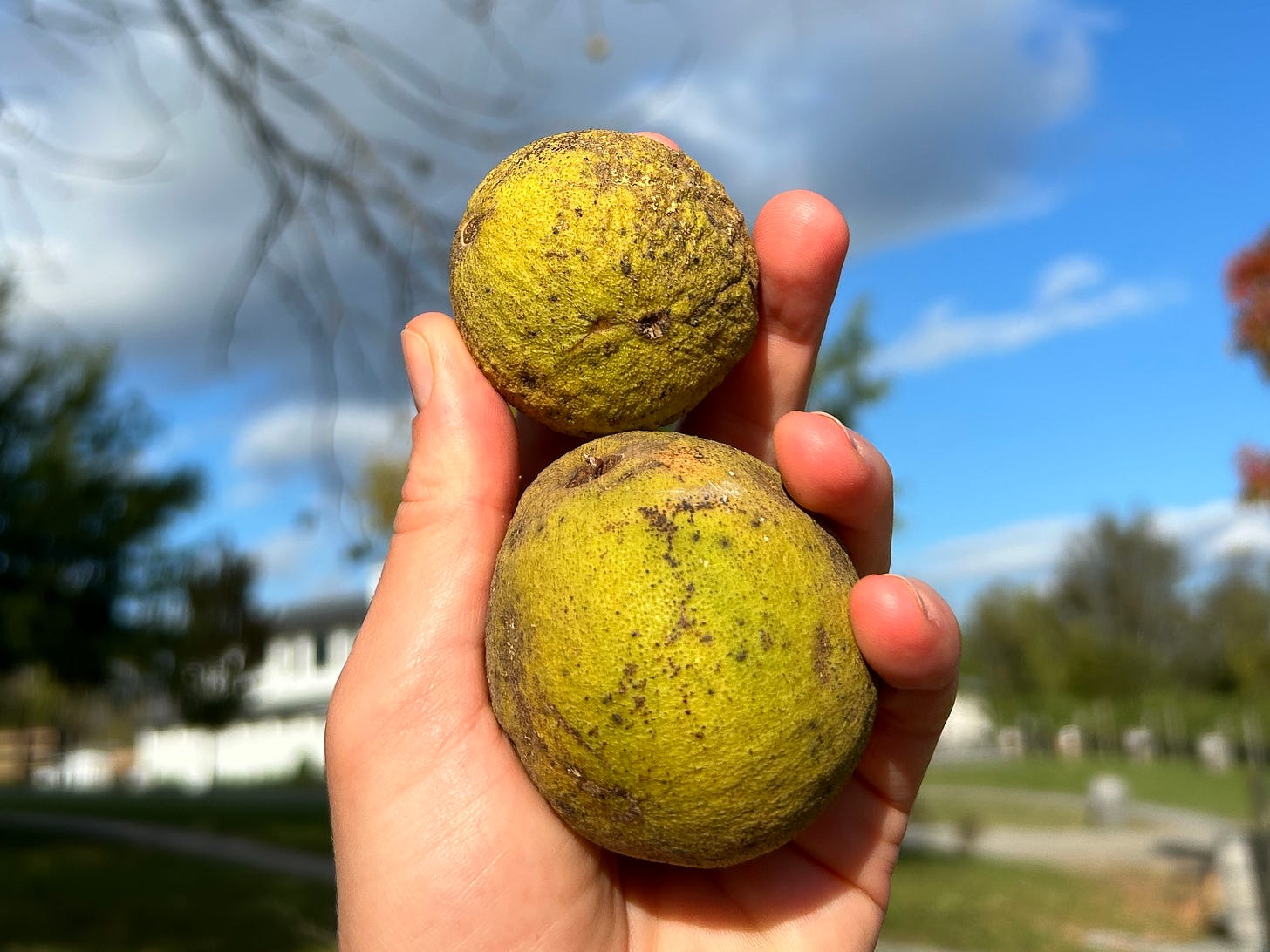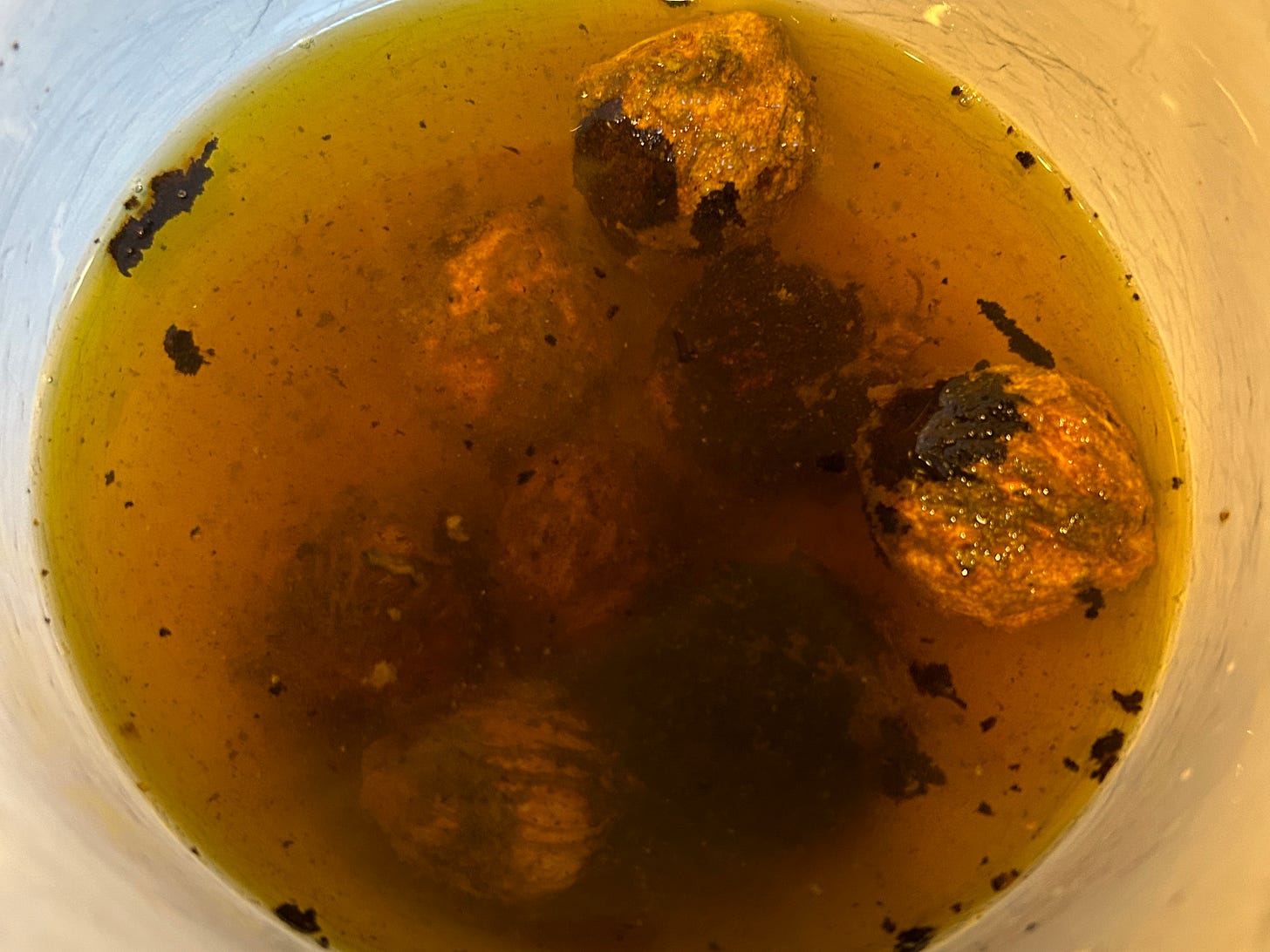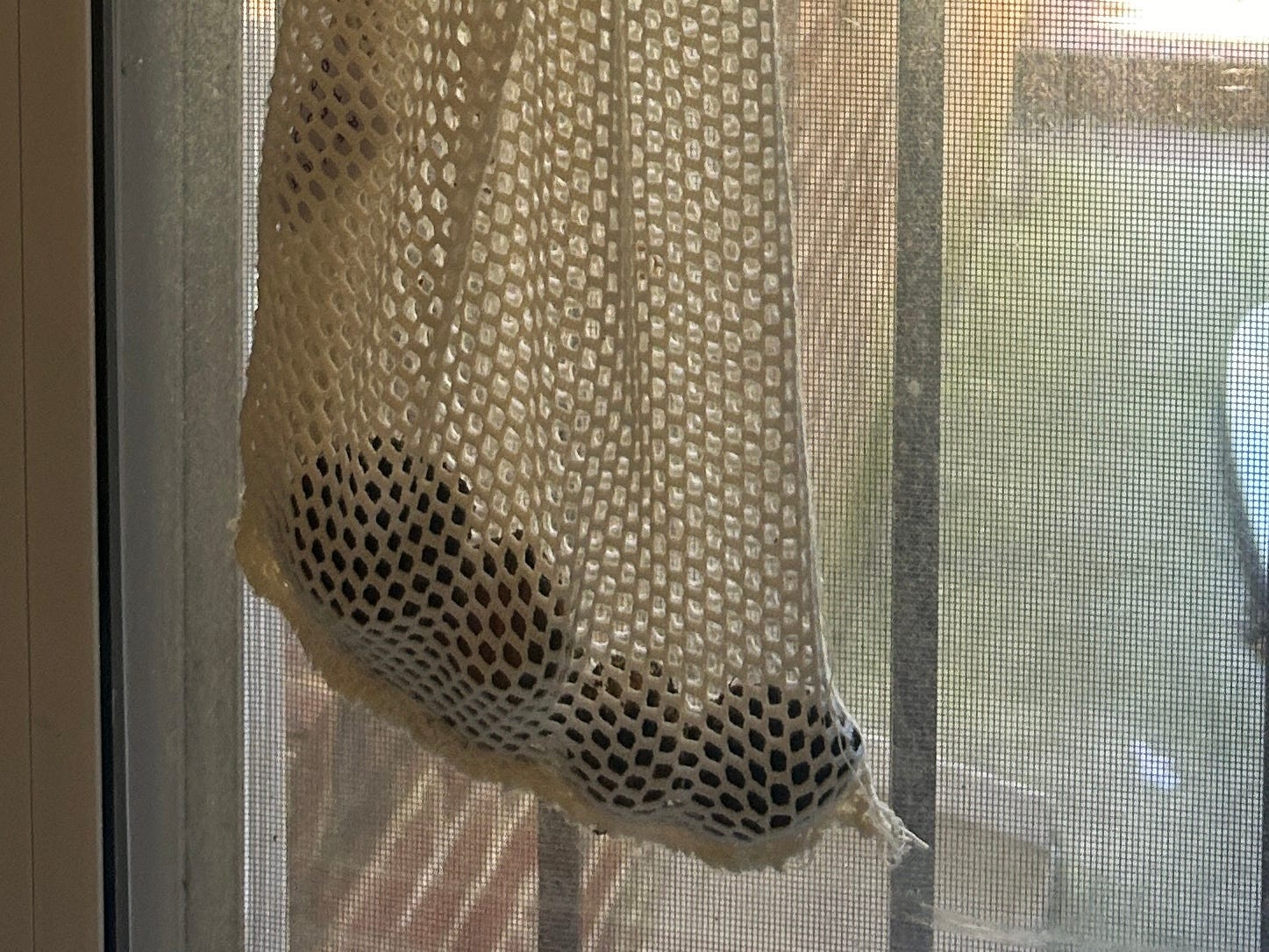black walnuts
a laborious snack beneath your feet
If you live in Washington, DC–or really anywhere from the Mid-Atlantic to Midwest–you’ve likely stumbled across these decomposing green orbs at some point. Perhaps a firm, green one has threatened to roll your ankle, or an extra soft, dark-brown one has squished into the bottom of your favorite pair of shoes. If you look up, the orbs, hanging from their tree branches, look like they belong in the universe of Dr. Seuss.
These green orbs littering the sidewalks of DC are actually what some consider a regional delicacy–edible black walnuts.
The walnuts typically sold in grocery stores and restaurants are English walnuts, also known as Persian walnuts, which are easier to harvest and milder in flavor. While harder to find on the shelves, black walnuts have a richer, earthier, bolder flavor and boast the highest protein content of any tree nut.
Native to 32 states, black walnut trees are distinctly American. They’re even the official state tree of Missouri. They are the only all-wild tree nut growing in the United States; meaning, all other tree nuts grow in orchards. Black walnut trees can tower up to 130 feet and have deep roots that help them stay stabilized on the edges of water sources—they line the banks of Rock Creek here in DC.
In early fall, you’ll see black walnuts encased in a thick, light-green husk, falling from trees and scattering the ground. That means they’re ready for harvest. I’ve seen many foragers suggest harvesting black walnuts when the green husk has turned dark-brown and begun to decompose, and therefore soften. At this stage, the husk simply falls apart when rolled or peeled. However, I read from one source that harvesting walnuts once they have begun to decompose can give the nutmeat an off-flavor. I’m not sure if I believe that since most sources did not mention this, but just to be safe, I decided to focus on the fresher, green-husked walnuts for my first harvest.
Green husks certainly require a bit more effort. It took a pairing knife and a lot of thumb strength for me to peel off all of the husk to uncover the recognizable walnut shells hidden within. I’ve seen suggestions to remove the husks by stomping on them, pounding them with a hammer, or even driving over them with a car or a lawn mower.
Once peeled, I soaked the walnut shells in water and scrubbed off as much remaining dark material from them as I could. I did this quite a few times–perhaps five–before I felt it was as clean as it was going to get. I threw out the two walnuts that floated to the top, which is an indicator of bad nuts.
If you decide to harvest your own walnuts, be warned–the husk will stain your hands and anything it touches. Many native groups, including the Cherokee, use the husks, roots, and the bark of black walnuts to make brown and black dyes. I didn’t wear gloves and had brown fingernails and fingertips for a few days after my harvest.
Once my walnuts were as clean as I could get them, I patted them dry (with a towel I didn’t mind staining) and transferred them to a mesh bag for curing. If you don’t have a mesh bag, you can also lay them out flat on a baking tray. Black walnuts should be cured in a cool, dry space, for at least two weeks, preferably closer to a month.
If you attempt to cure your nuts outside, beware of squirrels who will find a way to steal your harvest. One time a squirrel chewed through my metal window screen to get to food I left on the counter inside, so I’m not underestimating them this time. I decided to hang my walnuts inside a closed window.
After three weeks, I took my cured walnuts out onto my patio where I secured them in a fabric bag and brought my hammer down. To my surprise, they cracked open pretty easily when hit in the right spot.
Once the shell cracked open, getting the nutmeat out was the tricky part. I picked mine apart with tweezers, wishing that I had a lobster pick on hand. To be honest, most of my pieces ended up crumbling apart or getting stuck behind nooks and crannies I couldn’t access. But, I was able to get out a solid few pieces to try.
Unfortunately, half of those pieces were dry and shriveled. I slid into Alan Bergo’s (also known as @foragerchef) DMs on Instagram to ask about this and was grateful when I saw a quick reply. Apparently, I picked the wrong tree. He said that sickly trees can abort their nuts, so who knows why my tree decided to abort half of its harvest, but that’s not my decision to question (wink).
Here comes the part I didn’t anticipate writing. I really didn’t enjoy the taste of the black walnuts. I knew they weren’t rancid—the tree to palate pipeline was clear—but they had almost a rancid, perfume-y taste to them. I was wondering if it was something unique to my walnuts until I read that, at a taste test of black walnuts at America’s Test Kitchen, tasters described the flavor as floral and unpleasantly bitter, and even questioned whether the nuts were rancid. I wasn’t crazy! I guess this is what black walnut lovers meant by “bold” and “rich” when describing the flavor. Let’s just say, I think it’s an acquired taste.
Just because they aren’t my personal favorite doesn’t mean the culinary history of black walnuts is worth overlooking. Black walnuts have been used in sweet and savory cuisines for centuries. Indigenous groups mixed black walnuts into breads, puddings, and soups, and boiled them to make a beverage. They can be candied, made into oil, sprinkled on salads, or eaten raw or roasted.
You also may have heard of nocino, the dark, sweet Italian liquor made from unripe walnuts, otherwise known as green walnuts. While the black walnuts are still on the tree, soft enough that the hard inner shell hasn’t fully developed yet, they can be picked, sliced in half (husk and all) and added to strong grain alcohol, such as vodka. You can then add spices or herbs before letting the mixture sit for a month, at which point it gets strained and sweetened with sugar, honey, or maple syrup. The next step: patience; the nocino needs to rest for at least 6 months for the tannins to soften. Alexis Nikole, known as @theblackforager, has shared a video of herself making nocino before. I might have to give it a try next year. Alternatively, you can buy nocino from somewhere like Boardroom Spirits, as I did a couple of years ago around the holidays at Reading Terminal Market in Philadelphia. I promise it doesn’t taste like my description of raw black walnuts. It’s an incredibly flavorful aperitif or digestive, and is also a delight drizzled over vanilla ice cream (think affogato but nocino instead of espresso).
Black walnuts aren’t only good for food and beverage. Indigenous groups used the bark of the black walnut tree as medicine, although in cautious moderation as it is known to be poisonous.
Black walnut shells—the hardest of all tree nuts—have been used as filtration material to separate crude oil from water, as filler in dynamite, and even as an abrasive cleaner for Navy submarines and the Statue of Liberty.
Today, Hammons Products Company is the premiere supplier of black walnuts in the U.S. A family-owned company based out of Missouri, Hammons hosts an annual black walnut harvest where thousands of community members bring baskets of their foraged black walnuts–millions of pounds per year–for processing. Hammons sells their own black walnut products, from raw nuts to black walnut oil and candy, directly to consumers, but they also are the supplier of most other black walnuts that are sold under other brand names, including Diamond, Best Choice, or Laura Lynn. There simply aren’t other black walnut producers willing, or able, to manufacture the finicky, wild nut on such a large scale. And because black walnuts are so difficult to crack, they are primarily sold in pieces, rather than whole walnuts.
If you’re interested in trying black walnuts but don’t want to harvest them yourself, give a Hammons product a try. But if you’re a special type of person who still wants to harvest your own black walnuts—after reading my description of their flavor, how long the process is, and how laborious the effort is to get a few tiny pieces of nutmeat out—then the next time you’re walking around and see the green orbs of black walnuts on the ground, scoop some up for yourself. Even Martha’s doing it!










